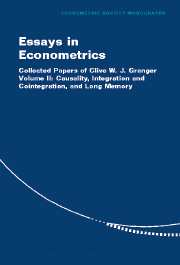Introduction
Published online by Cambridge University Press: 06 July 2010
Summary
At the beginning of the twentieth century, there was very little fundamental theory of time series analysis and surely very few economic time series data. Autoregressive models and moving average models were introduced more or less simultaneously and independently by the British statistician Yule (1921, 1926, 1927) and the Russian statistician Slutsky (1927). The mathematical foundations of stationary stochastic processes were developed by Wold (1938), Kolmogorov (1933, 1941a, 1941b), Khintchine (1934), and Mann and Wald (1943). Thus, modern time series analysis is a mere eight decades old. Clive W. J. Granger has been working in the field for nearly half of its young life. His ideas and insights have had a fundamental impact on statistics, econometrics, and dynamic economic theory.
Granger summarized his research activity in a recent ET Interview (Phillips 1997), which appears as the first reprint in this volume, by saying, “I plant a lot of seeds, a few of them come up, and most of them do not.” Many of the seeds that he planted now stand tall and majestic like the Torrey Pines along the California coastline just north of the University of California, San Diego, campus in La Jolla, where he has been an economics faculty member since 1947. Phillips notes in the ET Interview that “It is now virtually impossible to do empirical work in time series econometrics without using some of his [Granger's] methods or being influenced by some of his ideas.”
- Type
- Chapter
- Information
- Essays in EconometricsCollected Papers of Clive W. J. Granger, pp. 1 - 28Publisher: Cambridge University PressPrint publication year: 2001

